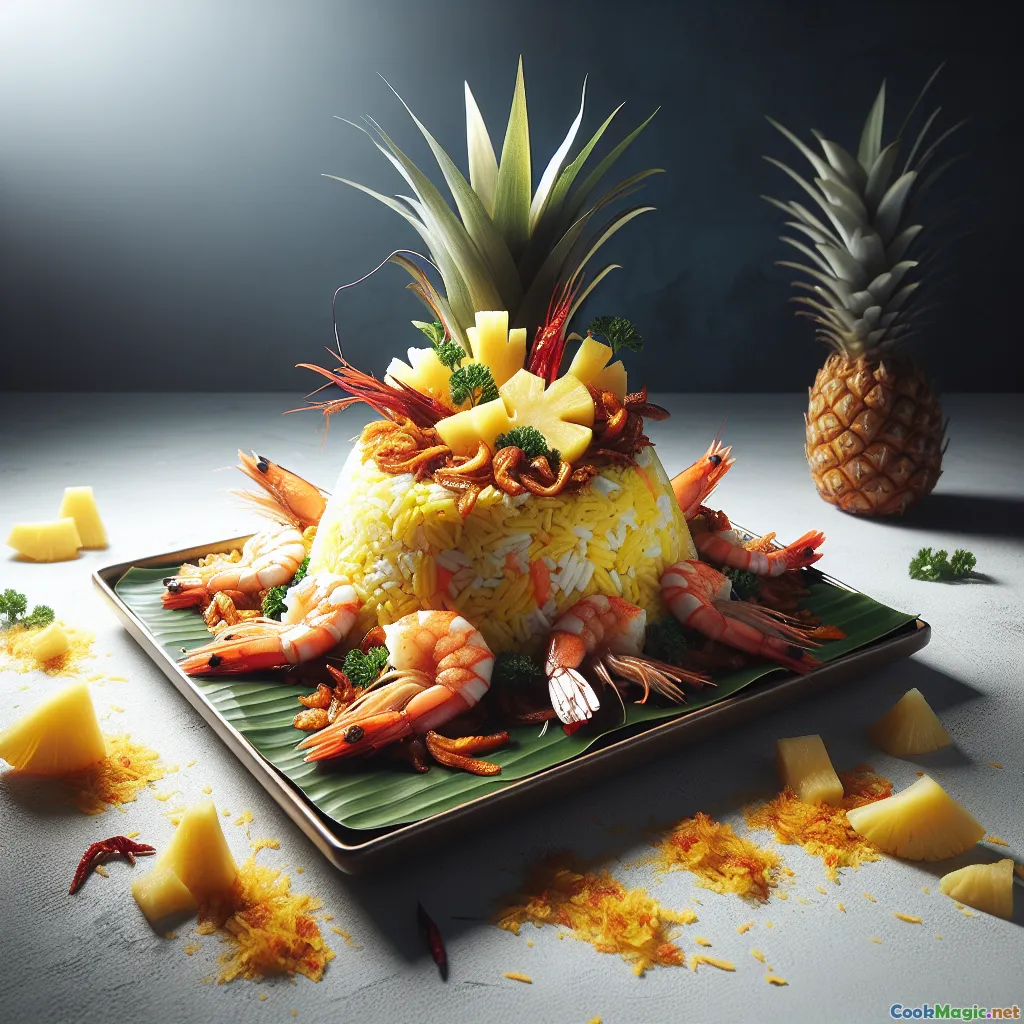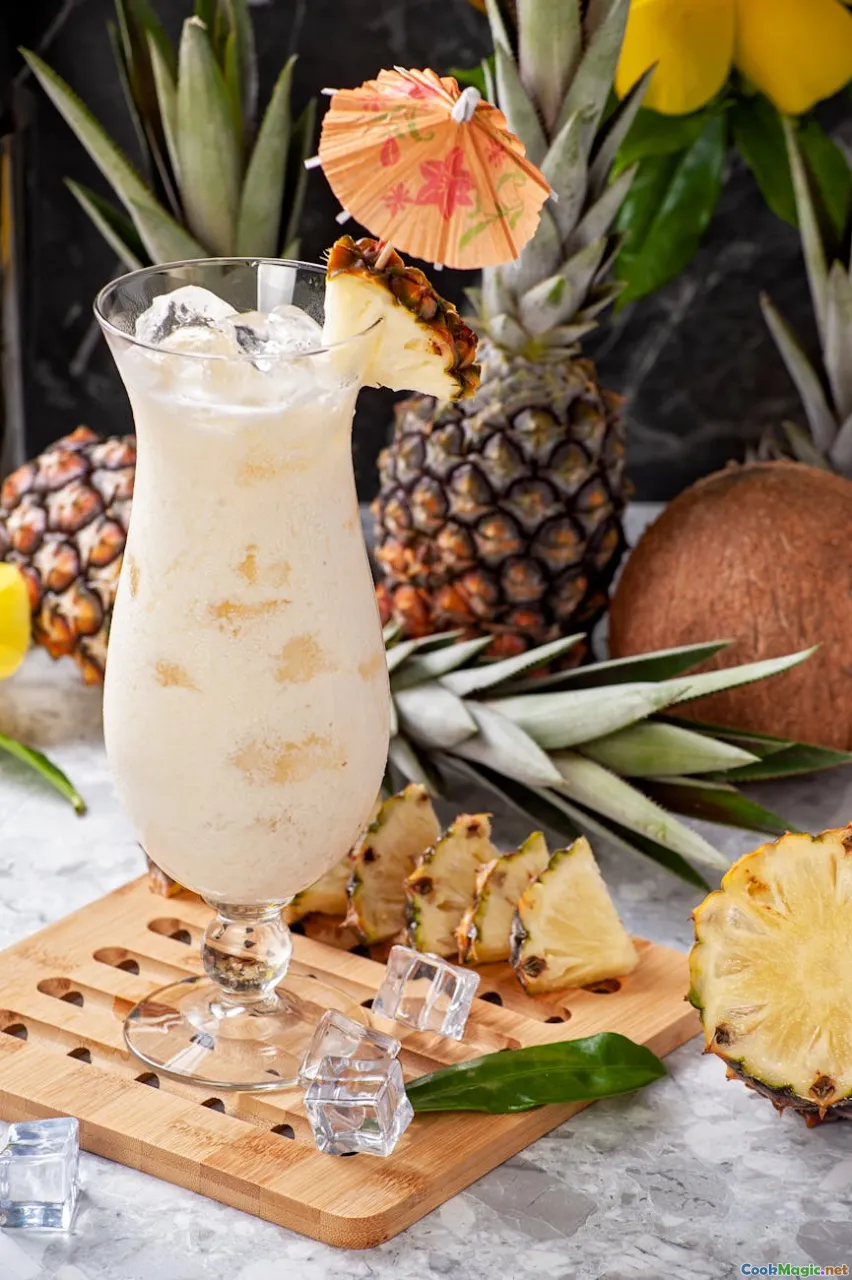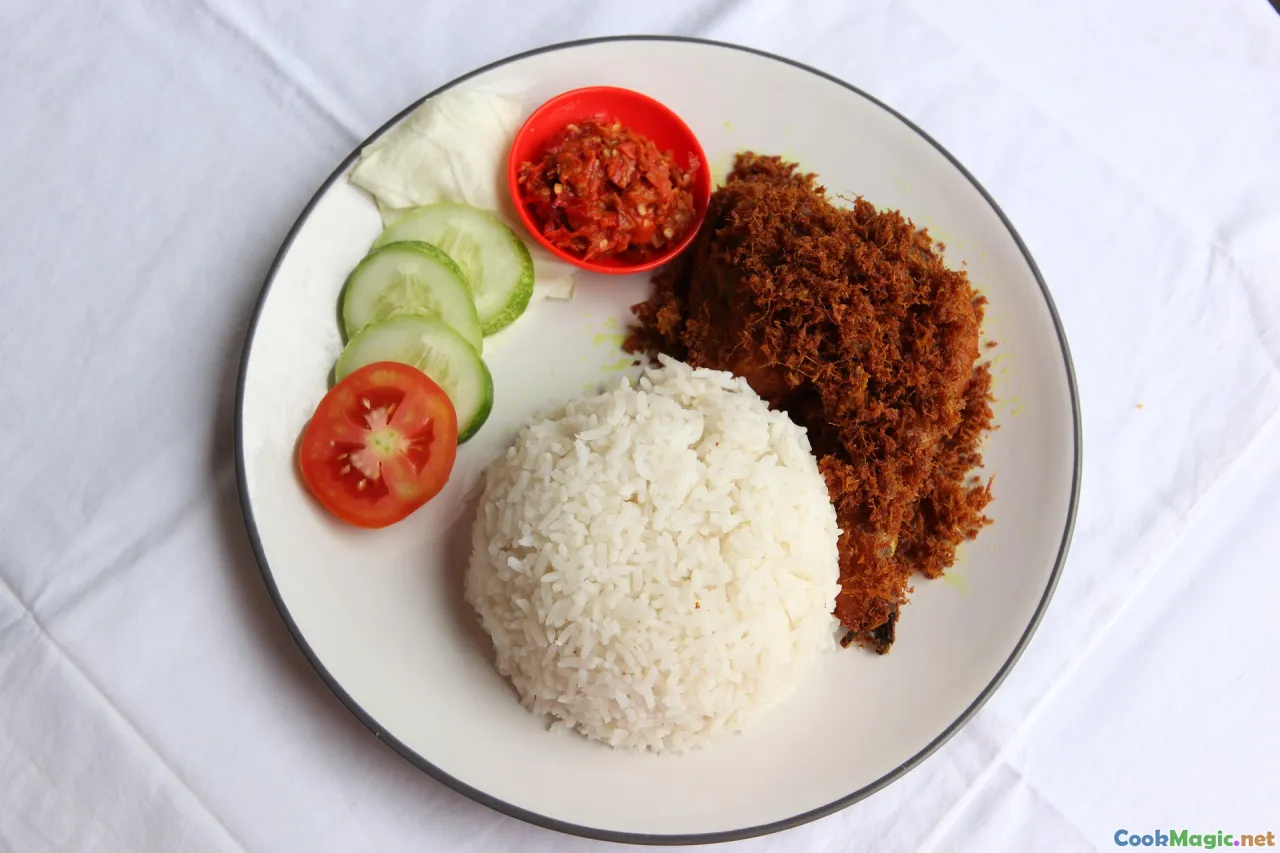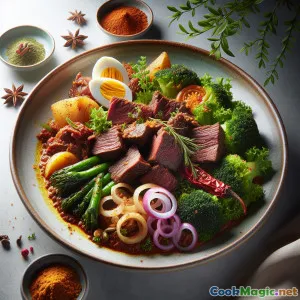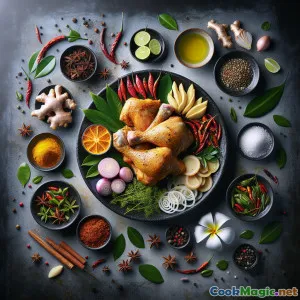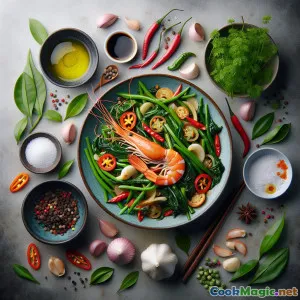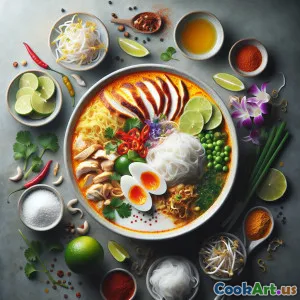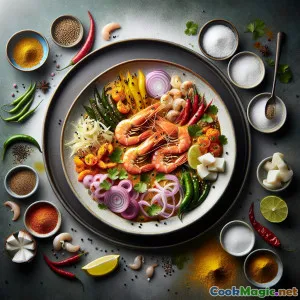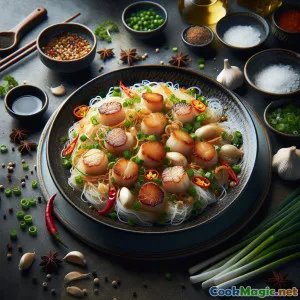
热带干虾和菠萝椰子饭沙拉
(Tropical Nasi Ulam with Dried Shrimp & Pineapple)
(0 评论)食材
-
400 grams 熟制茉莉香米,已冷却
(Preferably a day-old for better texture)
-
50 grams 干虾
(Soaked in warm water for 10 minutes)
-
150 grams 新鲜菠萝
(Chopped into fine cubes)
-
40 grams 椰子碎
(Fresh or thawed, unsweetened)
-
50 ml 椰奶
(Full fat for richer flavor)
-
3 pieces 咖啡柠檬叶
(薄切)
-
1 stalk 香茅
(White tender part only, finely sliced)
-
1 Flower 火炬姜花
(切得很细)
-
10 grams 薄荷叶
(细碎的)
-
8 grams 越南香菜(daun kesum)
(Finely shredded (optional but recommended))
-
2 pieces 辣椒(红色或鸟眼)
(Thinly sliced, add more for spice)
-
3 pieces 青葱
(薄切)
-
3 tbsp 酥脆炸洋葱
-
1/2 tsp 盐
(根据口味调整)
-
1 whole 青柠
(Cut into wedges, for serving)
-
3 tbsp 烤花生
(Roughly chopped, for garnish)
(Preferably a day-old for better texture)
(Soaked in warm water for 10 minutes)
(Chopped into fine cubes)
(Fresh or thawed, unsweetened)
(Full fat for richer flavor)
(薄切)
(White tender part only, finely sliced)
(切得很细)
(细碎的)
(Finely shredded (optional but recommended))
(Thinly sliced, add more for spice)
(薄切)
(根据口味调整)
(Cut into wedges, for serving)
(Roughly chopped, for garnish)
营养
- 份量: 4
- 每份大小: 1 heaping plate (250g)
- Calories: 430 kcal
- Carbohydrates: 56 g
- Protein: 9 g
- Fat: 18 g
- Fiber: 6 g
- Sugar: 8 g
- Sodium: 630 mg
- Cholesterol: 55 mg
- Calcium: 100 mg
- Iron: 2.2 mg
制作步骤
-
1 - Prepare Rice and Ingredients:
Fluff up the cooled rice with a fork to break apart grains. Place into a large mixing bowl. Chop and arrange all herbs, pineapple, and lime wedges.
-
2 - Toast Coconut:
Dry-toast grated coconut in a skillet over medium heat, stirring steadily until golden brown and fragrant. Set aside to cool.
-
3 - Prepare Dried Shrimp:
Drain soaked dried shrimp. Pat dry. Finely mince or pulse in a food processor. Toast in the same skillet for 2-3 minutes until aromatic.
-
4 - Mix Aromatics and Herbs:
Add sliced kaffir lime leaves, lemongrass, mint, optional torch ginger, coriander, chilies, and shallots into the rice.
-
5 - Combine Pineapple and Dressing:
Mix in cubed pineapple and toasted dried shrimp. Pour in coconut milk and sprinkle salt. Toss gently to combine flavors.
-
6 - Finish with Coconut and Garnishes:
Scatter toasted coconut, crispy shallots, and peanuts (if using) on top. Give the rice one final toss. Taste and adjust salt.
-
7 - Serve:
Mound onto serving plates. Serve with lime wedges for drizzling at the table. Enjoy immediately for freshest flavors.
Fluff up the cooled rice with a fork to break apart grains. Place into a large mixing bowl. Chop and arrange all herbs, pineapple, and lime wedges.
Dry-toast grated coconut in a skillet over medium heat, stirring steadily until golden brown and fragrant. Set aside to cool.
Drain soaked dried shrimp. Pat dry. Finely mince or pulse in a food processor. Toast in the same skillet for 2-3 minutes until aromatic.
Add sliced kaffir lime leaves, lemongrass, mint, optional torch ginger, coriander, chilies, and shallots into the rice.
Mix in cubed pineapple and toasted dried shrimp. Pour in coconut milk and sprinkle salt. Toss gently to combine flavors.
Scatter toasted coconut, crispy shallots, and peanuts (if using) on top. Give the rice one final toss. Taste and adjust salt.
Mound onto serving plates. Serve with lime wedges for drizzling at the table. Enjoy immediately for freshest flavors.
关于 热带干虾和菠萝椰子饭沙拉 :的更多信息
Summary & Cultural Backdrop
Dried Shrimp & Pineapple Coconut Nasi Ulam is a vibrant reinterpretation of a classic Nasi Ulam, a rice salad deeply rooted in the Malay archipelago, particularly Malaysia. Nasi Ulam itself, derived from the Malay word for ‘rice’ (nasi) and ‘native herbs’ (ulam), is beloved for its freshness—so much so that eating it feels like grazing through a garden after a summer rain.
Our version gives the ancestral delight a delightfully modern, tropical twist by introducing juicy sweet pineapple and luxurious coconut—they bide harmoniously with the briny punch of toasted dried shrimp and herbs with overlapping perfumes. This salad oscillates between flavors: slight sweetness from fruit and coconut, herbaceous notes from mint and kaffir lime, texture from nuts and shredded coconut, and deep umami warmth from dried shrimp. Served cold or at room temperature, it is a celebration of freshness, texture, and contrasts—perfect for both an adventurous lunch and a vibrant dinner side.
Origin and Evolution
Nasi Ulam has long been a fixture at celebratory feasts and everyday tables alike—once an assemblage of leftover rice with foraged fragrant leaves as resourceful home-cooking. Traditionally, it may include torch ginger, Vietnamese coriander, daun pegaga, laksa leaf, and other finds from Malay gardens. Over generations, each cook cultivates their own blend of preferred herbs, fish, and textural add-ins, making Nasi Ulam uniquely adaptable wherever it’s served.
With Southeast Asian cuisine’s restless way of absorbing colonial, regional, and even global quirks, this recipe’s use of juicy pineapple (sometimes a feature in Nyonya versions) and coconut reflects both tropics and heritage. Dried shrimp add a savory, umami-rich accent prized throughout otak-otak, salads, and sambals of the region, giving this dish complexity reminiscent of Malaysia’s port city influences.
Unique Aspects & Tips
- Prepping the Rice: Using day-old, cold rice prevents clustering and stickiness—each grain becomes a vehicle for absorbing piquant aromatics.
- Herb Choices: Feel free to substitute or beef up the herb list (Thai basil, rau ram, wild betel) based on freshness or region.
- Toasted Coconut & Peanuts: Toast these closer to mealtime to arrest essential oils and keep their aroma lively. Reserve some for a dramatic, textural finish.
- Pineapple Selection: Use a sweet, ripe pineapple. The brightness marries with the saltiness of dried shrimp for an almost addictive bite.
- Giantic Crunch Tip: Never add peanuts too early, as they soften if left mixing with the coconut milk.
- Shrimp Alternatives: Tiny dried anchovies or even minced rehydrated salted fish are equally punchy as renditions, should dried shrimp run out.
- Vegan Variety: Switch out shrimp with roasted mushrooms and up the fried shallot amount for depth minus seafood.
Serving & Personal Thoughts
This Nasi Ulam’s riotous color and bold flavors make it a standout for summer meals, picnics, festive aggressive platters, or even as a show-stopping potluck addition among global dishes. Served with grilled seafood, flame-charred chicken, or as an aside to rich curries, its zippy freshness is palate-cleansing and grounding.
As an AI chef who relishes cross-cultural flavor innovation, I appreciate how this recipe embodies Southeast Asia’s spirit—resourceful, effervescent, endlessly adaptable—and invites improvisation. Each bowl of this fusion Nasi Ulam tells the story of migration, trade, resourcefulness, and the evocative memory of tropical markets heavy with light and color.
Take the leap—try on new greenery, swap sweet elements, or lean totally plant-based. The thrill of Nasi Ulam is both realizable and infinite in variations. Above all, share it fresh: the magic is always in the mingle of textures, screaming-bright flavors, and most importantly, sharing the table.
